Eastern Europe pet food industry stands firm despite inflation pressure
In the first half of 2023, the pet food market in Eastern Europe is experiencing an outstanding surge in retail prices.
In Poland, for example, the average cost of pet food in March 2023 jumped by nearly 43% compared with the previous year, according to a study by think tank UCE research and the WSB Merito University.
A similar trend was observed in other markets of the region. In Hungary, the average pet food prices spiked by 50% in early 2023 compared with the previous year estimates by the Federation of Hungarian Food Industries in January. The federation voiced concerns that in the unraveling cost-of-living crisis, consumer demand might be in peril.
These fears, however, did not materialize. The market turbulence fizzled out as inflation pressure largely eased in the second half of 2023.
“Cost-of-living crisis has had little impact on sales of pet care,” commented Aleksandras Bacevicius, research analyst with Euromonitor International.
“Historically, the pet care industry has proven to be more recession-proof than other FMCG industries,” Bacevicius added. “It recorded growth in previous times of economic hardship, such as during the Great Financial Crisis and the COVID-19 pandemic.”
Over the past decade, pet food prices in Eastern Europe have always risen above the average GDP growth, except for 2015, yet pet food sales have been constantly growing through this period.

Rising spending
In general, the pet care market in Eastern Europe added 5% in value in 2023 in constant unit price terms, with not only the essential pet food but products such as cat and dog treats and mixers thriving, Bacevicius reported.
Overall, spending per pet in Eastern Europe has continued to increase in 2023, with the average dog or cat owner spending around EUR$108 (US$118) annually, which is a 3% increase from last year, in constant unit price terms.
“The volume consumed by dogs and cats also continues to grow, confirming that more spending is not purely an effect of inflation, but also better calorific coverage,” Bacevicius said.
The dog and cat population in Eastern Europe shows a positive dynamic in 2023, recovering from a negative 1% growth in 2022, mainly due to a sharp drop in Ukraine’s pet indicators. Poland inflates the average for the region, growing at 1.4% in 2023.
Ukraine, Slovakia, Romania and the Czech Republic are experiencing drops in dog and cat populations. In 2024, Eastern Europe’s dog and cat populations are expected to continue to show a marginal growth rate.
The shift toward premium products continues to be one of the main trends in the market, with premium dog and cat food growing 6% in 2022 in constant unit price terms, according to Euromonitor International.
“Nevertheless, the cost-of-living crisis effect on the industry is not nonexistent,” said Bacevicius. “Some pet owners turned to cheaper private label offerings, with private label value shares in dog and cat food growing ahead of the inflation rate, at 15% in current price terms in 2022.
“In 2023, economy and premium price segments are growing faster than mid-priced pet food, both in value and volume, which hints at slight price segment polarization,” he added.
Bacevicius believes 2024 is expected to be another year of growth for pet care in Eastern Europe, with both value and volume growing at a more modest 4% and 3%, respectively.
Exports are an industry’s backbone
Over the past two years, Eastern Europe has strengthened its position as the exporting region, primarily thanks to Poland, which became the world’s fifth largest pet food exporter in 2022, research conducted by the Polish Economic Institute showed.
Pet food is one of the most important commodities in Polish exports. In 2022, export sales totaled EUR$1.9 billion (US$2 billion), equal to 4% of the Polish agrifood exports.
Over the past decade, Polish pet food exports skyrocketed by 461 in monetary terms and 180% in physical terms. Poland accounts for 4.6% of the global pet food exports, the Polish Economic Institute estimates.
Poland exports pet food primarily to other EU countries, with 34% of all deliveries landed in Germany, 5.4% in Italy and 5.3% in France and the Czech Republic.
Last year, the analysts claimed the figures were poised for further growth, primarily thanks to the opening of the Chinese market for the Polish pet food industry in June 2023.
